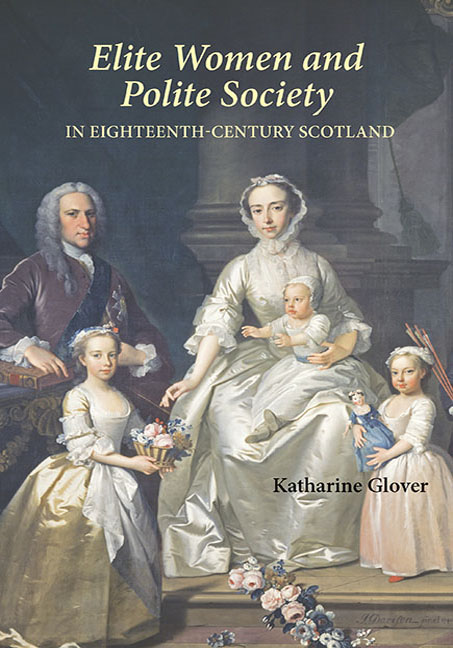Book contents
- Frontmatter
- Contenst
- Dedication
- Acknowledgements
- List of Abbreviations
- Preface
- 1 Elite Women and Eighteenth-Century Scottish Society
- 2 Education and Upbringing
- 3 Reading and Print Culture
- 4 Polite Sociability: Space and Social Practices
- 5 Politics and Influence
- 6 Travel, Tourism and Place
- Conclusion
- Appendix Biographical Backgrounds
- Bibliography
- Index
5 - Politics and Influence
Published online by Cambridge University Press: 08 April 2017
- Frontmatter
- Contenst
- Dedication
- Acknowledgements
- List of Abbreviations
- Preface
- 1 Elite Women and Eighteenth-Century Scottish Society
- 2 Education and Upbringing
- 3 Reading and Print Culture
- 4 Polite Sociability: Space and Social Practices
- 5 Politics and Influence
- 6 Travel, Tourism and Place
- Conclusion
- Appendix Biographical Backgrounds
- Bibliography
- Index
Summary
‘Troubled about the Publick’?
In 1756, Margaret Steuart Calderwood wrote from Brussels of the distress felt over public affairs by a Jacobite acquaintance, 'Lord Bellow', an Irish peer. ‘I tell him I wish I may never have the toothack till I be troubled about the publick,’ she reported. The previous two chapters investigated women's engagement with the worlds of print culture and polite society. For Habermas, these formed the ‘literary’ public sphere, differentiated from the ‘political public sphere’ by the ‘factual and legal’ exclusion of women and dependants. Margaret Calderwood's protestations of lack of interest in ‘the publick’ might appear to support this exclusion, but the rest of her journal, allied to other activities, suggests a more complex picture. She continued that she could nevertheless ‘speak as much jacobitism as ['Bellow'] pleases’, whilst her correspondence elsewhere exposes her determinedly attempting to manage a campaign for her husband's election to parliament. As the next chapter will demonstrate, she travelled abroad with a conscious sense of national identity. She may have been less interested than her friend in the affairs of state and high politics, and she may, like her Irish contemporary Letitia Bushe, have viewed such issues as simply unworthy of her attention. Despite her claims, however, aspects of the ‘publick’ infused her existence.
As Lawrence Klein has demonstrated, contemporaries used ‘public’ to mean much more than just ‘pertaining to the state’; indeed, it often referred to the arenas of sociability examined in the last chapter. Not surprisingly, Habermas's statement has been the starting point for much debate and analysis which has sought to demonstrate that women's de facto exclusion from offices of state did not expand to exclude women from any involvement in public concerns, aspects of which permeated society. Amanda Vickery, citing women's multiple uses of the word ‘publick’, has argued that although women ‘were obviously severely disabled when it came to institutional power, they did not lack access to the public sphere, as they understood it’. How, then, did elite women understand ‘the public sphere’ and their relation thereto? Hilda L. Smith, arguing for ‘a broader and more inclusive understanding’ of politics amongst seventeenth-century women than exists today, suggested that ‘as with others of their era, they would have thought more about obligations, less about privileges, and little about rights when discussing politics’.
- Type
- Chapter
- Information
- Elite Women and Polite Society in Eighteenth-Century Scotland , pp. 110 - 138Publisher: Boydell & BrewerPrint publication year: 2011

